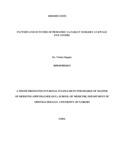| dc.contributor.author | Ongore, Vivian | |
| dc.date.accessioned | 2019-01-22T07:34:23Z | |
| dc.date.available | 2019-01-22T07:34:23Z | |
| dc.date.issued | 2018 | |
| dc.identifier.uri | http://hdl.handle.net/11295/105220 | |
| dc.description.abstract | ABSTRACT
Objective
To assess the outcome of childhood cataract surgery in Kwale Eye Centre of surgeries performed
between 1st January 2013 and 30th June 2016; to assess various factors such as pre-and post-operative
visual acuity, complications that occurred intra and post-operatively and their pattern.
Methods
The study was a retrospective case series conducted at Kwale Eye Centre which is a hospital found in
Kwale County of Kenya. Records of all children less than 15 years old who had surgery for congenital
or developmental cataracts during the study period were assessed. Data was entered into a pre-formed
questionnaire and analyzed. Descriptive analysis was undertaken to determine outcomes.
Proportionate test was used to compare proportions. Chi square was used to test factors associated
with poor outcome.
Results
Seventy-four patients (128 eyes) were included in this study the M: F ratio was 2:1. Most eyes were
blind pre-operatively (42.2%). With available correction 47.0% of eyes had good and borderline visual
acuity at the week twelve follow up visit. Most eyes were lost to follow-up by week 12 (61.7%).
The commonest early and late post- operative complications were corneal haze (11.72%) and posterior
capsular opacity (21.05%) respectively. Post-operative complications (fibrinous uveitis), uncorrected
refractive errors and pre-operative ocular comorbidities contributed to poor outcomes.
Refraction was done in most patients (92.9% of eyes) but spectacles were given only to 30% of
children.
xii
Conclusion
The percentage of eyes with good visual outcome was below WHO recommended standards 46.4
versus the recommended 80%. The intraoperative complication rate was low (10.1%) the commonest
was hyphema which occurred in 2 eyes which thereafter resolved. The commonest early postoperative
complication was corneal haze which was encountered on day 1 while the commonest late
complication was posterior capsular opacity. Pre-operative ocular comorbidities (disc & chorodial
coloboma, maculopathy, retinitis pigmentosa), post-operative fibrinous uveitis and uncorrected
refractive errors contributed to poor visual acuity.
Recommendations
A standardized tool for capturing pre-operative, intra-operative and post-operative notes should be
designed and used to avoid erroneous or missing data.
A vitrector should be functional at all times when doing cataract surgery in children so as to prevent
PCO formation. Biometry should be done for all patients pre-operatively. Spectacles should be issued
to all patients with post-operative refractive error. | en_US |
| dc.language.iso | en | en_US |
| dc.publisher | University of Nairobi | en_US |
| dc.rights | Attribution-NonCommercial-NoDerivs 3.0 United States | * |
| dc.rights.uri | http://creativecommons.org/licenses/by-nc-nd/3.0/us/ | * |
| dc.subject | Pediatric Cataract Surgery At Kwale Eye Centre | en_US |
| dc.title | Pattern And Outcome Of Pediatric Cataract Surgery At Kwale Eye Centre | en_US |
| dc.type | Thesis | en_US |
| dc.description.department | a
Department of Psychiatry, University of Nairobi, ; bDepartment of Mental Health, School of Medicine,
Moi University, Eldoret, Kenya | |



